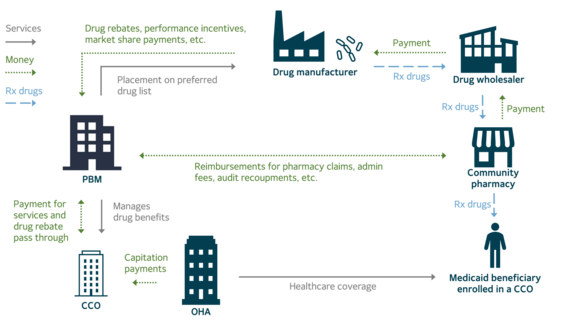State Auditors Find Complexity Around Pharmacy Benefit Managers Makes it Difficult to Assess Their Value to Oregon’s Medicaid Program
SALEM, OR — The Oregon Audits Division released its latest audit of the Oregon Health Authority today, focused on Medicaid and the role of Pharmacy Benefit Managers, or PBMs — little-known but highly influential players in the health care system.
The audit found the current structure of PBMs is too complex for the state to fully assess and understand the value they provide, which is especially important in an already-expensive program like Medicaid. Furthermore, the audit found the state’s regulation of PBMs is limited and fragmented. Much of the work PBMs do is considered proprietary and not shared.
“It’s always important we make sure taxpayer funds are being spent as effectively as possible, and Medicaid is a prime example,” said Audits Director Kip Memmott. “It’s the largest and most complex government program in Oregon and provides critical health services to more than one million Oregonians. But the lack of transparency in our current system means it’s almost impossible to tell if we’re truly getting the best use of our funds with these PBMs.”
PBMs are third-party companies who act as go-betweens among insurance companies, drug manufacturers, pharmacies, and governments. While initially created in the 1960s to ease the administrative burdens of insurance companies, the role of PBMs has expanded significantly over time. Among their many responsibilities, PBMs can influence which drugs are covered by insurance companies and whether certain prescriptions can only be filled at specialty pharmacies.
 PBMs are able to wield this influence to benefit certain companies over others. The three largest PBMs in the United States control 80% of the market share and are integrated with health insurance companies and retail pharmacies like CVS and OptumRx. By controlling the price at which drugs get reimbursed, as well as the pharmacy that will fill the prescription, these companies can ensure the pharmacies they own get greater reimbursement rates than independent pharmacies — in some cases, twice as much.
PBMs interact with Oregon state government through contracts with Coordinated Care Organizations (CCOs). A CCO is a network of health care providers who work together in their local communities to serve people covered by Medicaid. Together, Oregon’s 16 CCOs contract with the Oregon Health Authority to manage about 90% of Medicaid clients in Oregon.
PBMs, as subcontractors of the CCOs, receive huge sums of money. CCOs reported spending $767 million on prescription drug benefits in 2021, but because of the complexity and trade secrets surrounding PBMs, it’s virtually impossible to know how much profit they are actually making — and how much of that profit is coming from Oregon’s Medicaid funds.
Auditors found other states have legislation to provide greater protections for patients and pharmacies, and more transparency into this complicated system. There are also alternative PBM models available for Medicaid, which make it easier for governments to provide effective oversight. Auditors made seven recommendations to the state Legislature suggesting Oregon look into adopting some of these alternatives.
 Auditors also made two recommendations to the Oregon Health Authority for more immediate improvements. The agency could do more to improve transparency and compliance from its current relationship with PBMs — through CCOs — by proactively monitoring and enforcing its contracts. In its formal response accompanying the audit, the agency agreed with both recommendations.
“We audit state agencies and programs like this one to provide meaningful feedback on how agencies can improve their operations to better achieve their missions and goals,” Memmott said. “This work becomes even more critical when significant amounts of money or vulnerable people are involved.”
Read the full audit on the Secretary of State website.
|